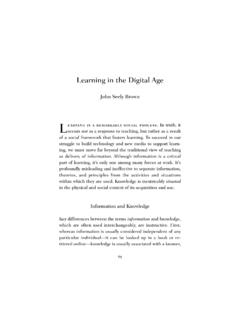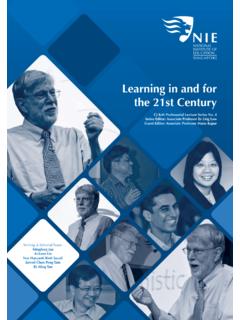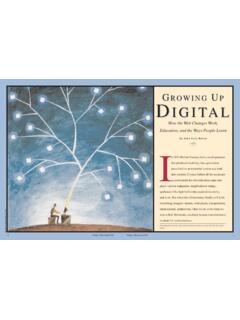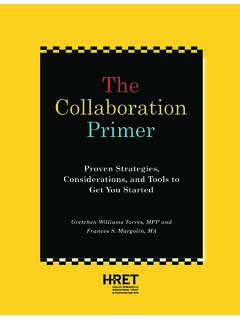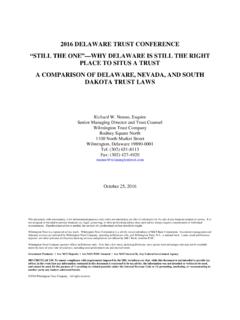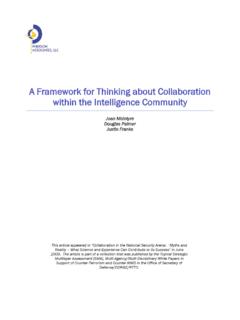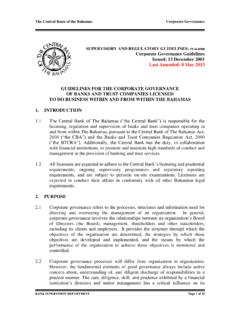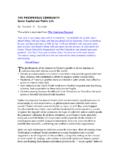Transcription of Control vs. Trust Mastering a different …
1 Control vs. Trust Mastering a different management approachBy John Hagel and John Seely BrownBusiness confronts intensifying competition and growing uncertainty. Such conditions naturally favor the Control mindset: managers batten down the hatches, bring all resources required for business success under their direct Control , and rely on no one else. Micro-manage all activities. Keep everything by the book and don t tolerate any exceptions. Squeeze the maximum out of every resource and every there s a problem: Businesses aren t self-sufficient. If anything, they are becoming increasingly interdependent. Lean supply chains require significant collaboration between suppliers and customers. Adding value around products and services often demands greater collaboration between vendors and a complex array of channel partners.
2 The quest for more operating cost efficiency traditionally leads to business process outsourcing. Getting costs out of products calls for more collaboration between a company s product design staff, component suppliers and outsourced only is collaboration increasing, so is the need for flexibility. We just don t know any more where markets are headed. Customers are increasingly ready and able to move to the best offer. Competitors are entering markets from unexpected directions both in terms of geography and industry. Technology innovation continues to deliver radically new capabilities. We thought for a while that business cycles with their wrenching shifts in demand patterns were a thing of the past. As if all that weren t bad enough, then we had September 11 and the growing prospect of disruptive terrorist Control mindset cannot cope with this.
3 Control requires the ability to dictate all activities. Control seeks to preserve stability and predictability. The forces at work in business today will make Control -based management approaches less and less effective. Even information technology that was once the ally of, and shaped by, the Control mindset is moving along a different path. New IT architectures in particular, distributed service architectures shaped by Web services technology are creating much more flexible platforms for business need to return to basic principles to discover a different approach to management one that can fully exploit the economic potential of collaboration and flexibility. Ultimately, managers want to be assured of two things: that parties will deliver end products as promised and that parties will not abuse privileged access to corporate resources and relationships to the detriment of the corporate owner.
4 Control is one, increasingly less effective, way of assuring these two things. Trust offers a different management approach designed to assure the same focuses on establishing shared expectations regarding end products, rather than specifying in detail the actions that must be performed to deliver the end products. Trust -based management then concentrates on designing appropriate incentive structures and reducing barriers to motivate appropriate action. It rests upon the recognition that performance generally falls short of expectation for one of two reasons either the parties lack the will ( , they are not sufficiently motivated) or they lack the skill ( , they don t have the capability to act). Of course, there is a third reason that performance falls short unanticipated events like terrorist attacks, earthquakes, or accidents can wreak havoc on the best of intentions and capabilities.
5 As we will discuss, Trust -based management approaches can also help to insulate businesses from these unanticipated events better than more conventional Control -based focusing on end products, rather than the detailed activities required to deliver the end products, the Trust -based approach creates the basis for a very different management model. Rather than supporting tightly coupled business activities, Trust -based approaches encourage much more loosely coupled business activities. Participants can be added and removed much more easily. More specialization can occur because loosely coupled relationships can accommodate more participants. Rapid innovation can occur in all areas of business activity because the loose coupling allows participants to change the way they operate without disrupting the operations of others.
6 Control vs. Trust This article explores the key elements of a Trust -based management approach . It will make the case that Trust is a much more versatile and powerful way than Control to deliver business results in an increasingly interdependent and uncertain world. But it will also suggest that Trust approaches require management to develop a very different set of skills. Since Trust approaches can only be implemented gradually, management has an opportunity to learn and acquire these skills along the way. The key at the outset is to shift from a Control mindset to a Trust mindset and to understand the kinds of skills that will be required to succeed in moving to a very different management approach . The components of truustTrust-based management does not start with the assumption that all parties can or should be trusted.
7 Quite the opposite. This approach begins with the assumption that Trust must be actively built and maintained. This becomes one of the key challenges for is required to build and maintain Trust ? Four broad elements must be addressed:Expectations must be shared by all parties All parties must be sufficiently motivated to deliver against expectations All parties must have the requisite capabilities to deliver against expectations Notification mechanisms must be in place to provide early warning of any potential shortfalls in performance or abuse of privileged accessShared expectations creating shared understandingTrust ultimately depends upon a clear understanding of expectations regarding end products. Under a Control approach , managers can intervene at any moment to clarify their expectations.
8 In contrast, Trust approaches require reasonable investment at the outset to ensure that expectations are appropriately set so that the various parties can proceed on their own initiative. Of course, over time, as the various parties get to know each other and understand the expectations of all involved, less effort is required to ensure that this element is in the early stages of building Trust relationships, managers need to ensure that all parties understand each other well enough to be able to establish shared expectations regarding end products. If one manager says that the product needs to be blue, do the other parties understand how tight the color specification really is? If it is tight, do they understand precisely what shade of blue must be delivered?
9 Too often, Trust is eroded because the various parties attach different meanings to specifications of end setting shared expectations, managers need to resist the temptation to over-specify the end products or to specify actions required to create the end products. One of the greatest strengths of a Trust approach is that it creates flexibility for the various parties to innovate to come up with more efficient and effective ways to create the end product. Over-specification reduces degrees of freedom and thereby limits is particularly counter-productive when the specifications start to intrude upon the activities required to deliver the end product. For example, it may be tempting for a manager to specify that a supplier must produce the color blue by sourcing a dye from a particular supplier and using the dye in a prescribed procedure.
10 This usually suggests that the Control approach is creeping back in. Managers need to continually check themselves to ensure that the end-product specifications are the minimal ones needed to support the business structures creating the will to performThe best way to ensure that parties will perform as expected is to create the right incentive structure to motivate appropriate behaviors. This is challenging enough within a single organization. It becomes even more challenging as the parties involved span multiple enterprises. Designing the right incentive structures requires a deep understanding of the economic drivers and aspirations of each of the participants. Given the great diversity of participants, it is rarely possible to implement a uniform incentive structure.
